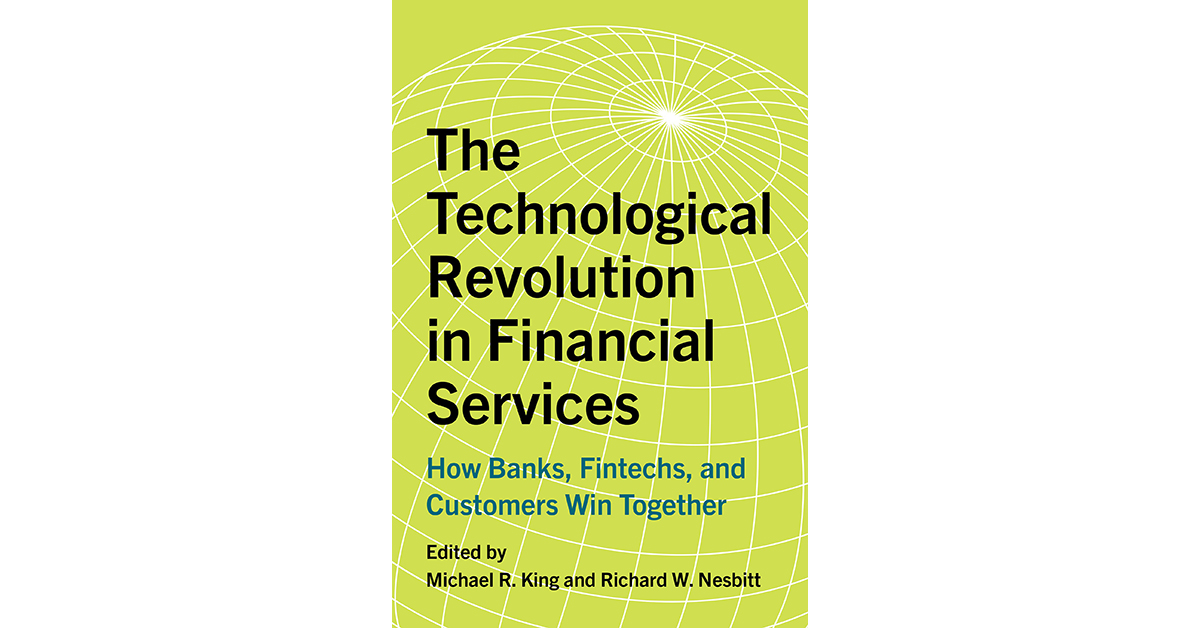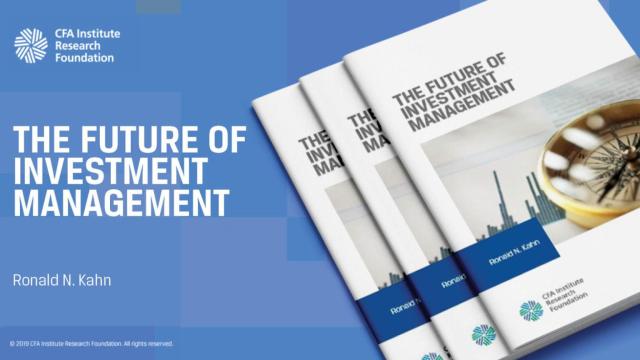[ad_1]
The Technological Revolution in Financial Services: How Banks, Fintechs, and Customers Win Together. 2020. Edited by Michael R. King, CFA, and Richard W. Nesbitt. University of Toronto Press.
The Technological Revolution in Financial Services: How Banks, Fintechs, and Customers Win Together, edited by Michael R. King, CFA, Lansdowne Chair in Finance at the University of Victoria’s Gustavson School of Business, and Richard W. Nesbitt, adjunct professor and executive in residence at the University of Toronto’s Rotman School of Management, constitutes a valuable resource for practitioners seeking a more thorough understanding of the evolving financial industry.
Change is a constant theme in banking and financial
services. This book outlines the strategic implications for financial services
firms in North America, Europe, and other advanced economies. The editors
contend that traditional banks, asset managers, and insurers (i.e., incumbents)
will continue to dominate financial services. However, the most successful
incumbents will partner with financial technology companies to provide better
and more innovative services to retail customers and small businesses at a
lower cost. This technological revolution will benefit customers and lead to a
more open and inclusive financial system.
The book provides a roadmap on how the financial industry
will evolve in response to three structural forces that are driving the
transformation of financial services globally:
- Heightened regulation in the wake of the global financial crisis (GFC).
- Innovation fueled by new technologies, including fintech 3.0 (beginning in 2009), whereby start-ups and new entrants deliver financial products and services directly to retail customers and businesses.
- Demographic changes, including the professional advancement of millennials and the retirement of baby boomers.
In my view, one of the unforeseen consequences of regulatory
responses to the GFC was that they facilitated a wave of innovation and
technological disruption, from both within and outside the financial industry.
National regulations, such as the US Dodd–Frank Act (2010) and the UK Banking
Reform Act (2013), made the financial sector safer and more stable than
formerly. However, these regulatory reforms also rendered the financial sector
less profitable, less liquid, and more fragmented. Competition from shadow banking
and other non-regulated players intensified.
An initial source of disruption was industry insiders who
left incumbent firms to launch entrepreneurial start-ups that drained the
industry profit pools. In addition, according to contributor Tiff Macklem, current
dean of the Rotman School of Management at the University of Toronto, the GFC
and its aftermath forced business schools and bankers to broaden the scope of
financial teaching. This broadening includes a renewed focus on culture and
ethics as well as the consideration of “non-financial” risks, such as those
from employee conduct, technological disruption, and climate change. Market
participants, including boards of directors and regulators, have come to
recognize the importance of culture in creating social norms that influence
what people do when nobody is watching. As an adjunct associate professor of finance
at the NYU Stern School of Business, I feel strongly that universities can also
provide more simulation-based experiential learning while moving the curriculum
beyond traditional finance topics to risk management.
Macklem describes two mega-forces affecting the economy, finance, and society — namely, technological disruption and climate change. New technologies, including artificial intelligence and blockchain, are creating new opportunities, but there should also be ways to commercialize innovations and equip start-ups with the requisite business judgment to succeed. A successful example is Rotman’s Creative Destruction Lab, which helps science-based ventures at the seed stage raise capital, scale their businesses, and resolve failures in the market for business judgment.
As a passionate advocate for addressing the risks of climate
change, I agree with Macklem on the need for sustainable finance to move beyond
its niche in financial markets to the mainstream. This shift is necessary because
more extreme weather events linked to climate change are generating more
frequent extreme-loss events. The financial sector has a critical role to play
in channeling savings to more sustainable investments and helping households
and businesses manage new climate-related risks.
The book’s final section outlines what actions senior leaders in the financial sector need to take to succeed in the fintech area. One of those actions is to improve gender diversity. According to Brenda Trenowden, CFA, former global chair of the 30% Club, the business case for gender balance is not just a social issue but also a performance issue. She summarizes a large body of research connecting increased gender diversity with improved financial performance, as measured by accounting metrics and market returns.
Besides listing the financial benefits, Trenowden explains
how gender diversity improves talent attraction and retention, innovation,
productivity, and customer engagement. She then outlines six concrete actions
senior leaders can take to increase gender diversity in their organizations:
- Recognize and address hidden biases.
- Diagnose the problem and set measurable targets.
- Provide gender-neutral job descriptions.
- Change hiring practices.
- Match women with senior sponsors.
- Provide female role models.
As an employee of a firm where 70% of the workforce is
either female or minority, I wholeheartedly agree with Trenowden’s sentiment
about the importance of gender diversity, as demonstrated by financial
performance improvement.
In summary, this book will help guide both incumbents and new entrants in the coming decade as the financial industry strives to put the customer first. The longest-lasting impact of the technological revolution in banking will be the improved customer experience. Successful financial intermediaries of the next decade will focus on the needs of customers, recognizing that this industry exists to serve them first.
If you liked this post, don’t forget to subscribe to the Enterprising Investor.
All posts are the opinion of the author. As such, they should not be construed as investment advice, nor do the opinions expressed necessarily reflect the views of CFA Institute or the author’s employer.
Professional Learning for CFA Institute Members
CFA Institute members are empowered to self-determine and self-report professional learning (PL) credits earned, including content on Enterprising Investor. Members can record credits easily using their online PL tracker.
[ad_2]
Image and article originally from blogs.cfainstitute.org. Read the original article here.




